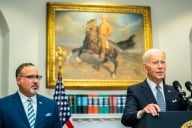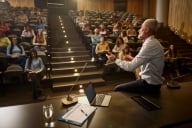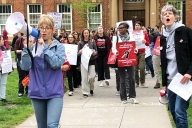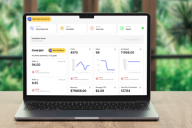You have /5 articles left.
Sign up for a free account or log in.
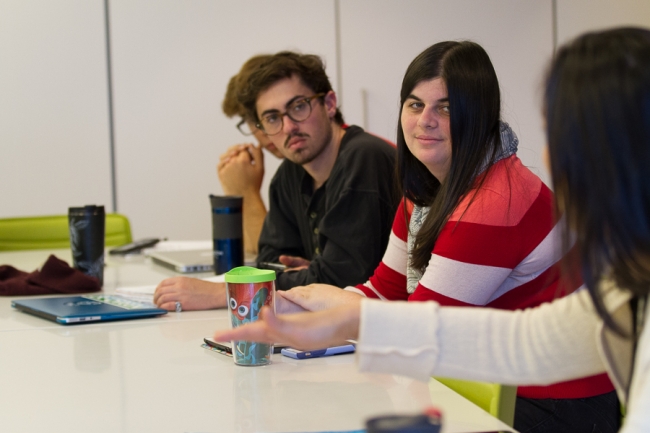
Bennington President Mariko Silver speaks to students during her pop-up class.
Briee Della Rocca for Bennington College
Not many students get to enroll in a course called The Semiotics of Trump, which examines the Republican presidential candidate’s rhetoric, nor do they earn credit in a course that examines the U.S. Department of Justice’s Ferguson Report.
They can at Bennington College. The college offered those courses in the spring semesters of 2016 and 2015, respectively. Both lasted a few weeks.
The temporary nature of the courses is intentional. They are pop-up courses, worth one or two credits, that are meant to encourage students to engage critically with the world’s events as they unfold. Similar to pop-up shops and restaurants, these courses only last a short time.
“We know that the world does not move in academic time,” said Bennington President Mariko Silver. “Students and faculty want to be engaging with what’s going on in the world, and we want to create intellectual and academic spaces to discuss those issues in the classroom.”
Both faculty and students can propose pop-ups, which are sent to a course committee of administrators and professors for approval on an expedited timeline. Faculty lead all the courses.
Silver is co-teaching a course this semester called Election 2016 and What Comes After. The course can only be taught once -- it’s not a postelection retrospective, but a seminar in which students analyze the presidential election as it happens.
Much like other pop-ups, it doesn’t span the entire semester. The first session was the week of the last debate, and the last class was taught on election night.
But just because the class is shorter than normal doesn’t mean Silver and her co-instructor, Noah Coburn, a professor of political anthropology, assign lighter material: students read both academic source material and news articles. They discuss media framing of the election and compare how the American democratic process differs from electoral processes in Bosnia and Herzegovina and Afghanistan. Students are required to write a final paper about the election’s impact.
“The biggest challenge is packing everything in,” Silver said.
That can make pop-up courses especially intensive. Even so, she said, pop-ups allow students to dip into rigorous introductions that may be outside their disciplines. And pop-ups aren’t limited to social sciences -- Bennington professors also have taught courses about measles and gravitational waves, for instance.
Pop-ups may be particularly appropriate for Bennington, which has a tradition of regularly changing its curriculum. The college allows students to design their own majors and lets students decide whether they want to be graded. Several other institutions have experimented with the short-term courses, but they usually aren’t offered for credit.
The Hasso Plattner Institute of Design at Stanford University -- dubbed the “d.school” -- began offering pop-ups in 2013.
Although the pop-up courses at both institutions have the same premise, Stanford’s pop-ups are noncredit courses with more unconventional time frames (a course might last for a weekend) and are offered to community members, too. All the courses are co-taught by two to four instructors.
Plus, at Stanford the focus of pop-ups is more on experimentation than current events. Because of the shorter duration of the courses, instructors can test interdisciplinary content and inventive methods of teaching that are not possible in regular curriculum courses, said Leticia Britos Cavagnaro, co-director at Stanford’s University Innovation Fellows Program and an adjunct professor at the d.school.
Sometimes the university’s pop-ups can be molded into for-credit courses.
Last year, Britos Cavagnaro taught a pop-up, which was divided into three evening sessions, about how to integrate design thinking into negotiation tactics. Then she taught a separate course on a Saturday on how to use techniques from improvisational theater at the negotiation table.
This semester, some d.school students enrolled in Negotiation by Design, a for-credit class developed from those two pop-ups.
The d.school also trains students from universities all over the country through its University Innovation Fellows Program, which teaches students how to integrate inventive strategies and programs at their home colleges. One of those strategies is the use of pop-ups.
Students from the University of Maryland, Utah Valley University and Kettering University have all returned home and experimented with some sort of pop-up, according to Britos Cavagnaro.
After participating in the Stanford program, Timothy Moore brought pop-ups to James Madison University last summer, when he was a senior. JMU’s X-lab has used pop-up classes, which both professors and professionals from the local area teach. The center offers pop-ups on 3-D printing, virtual reality and, on Halloween, sketching pumpkins with lasers.
Moore has since graduated, and he’s now running the pop-ups and workshops program at the Claremont Colleges in California.
Although the pop-ups at Bennington and Stanford are relatively new, some colleges have offered similar programs for years. The University of California, Berkeley, for instance, has allowed students to propose and teach one-semester classes through its DeCal program since 1965.
Pop-ups may not fit into every university’s curriculum. But that’s the point, said Britos Cavagnaro.
“Pop-ups challenge our assumptions about traditional classes and courses,” she said. “They allow faculty to be more experimental and students to try something new.”

